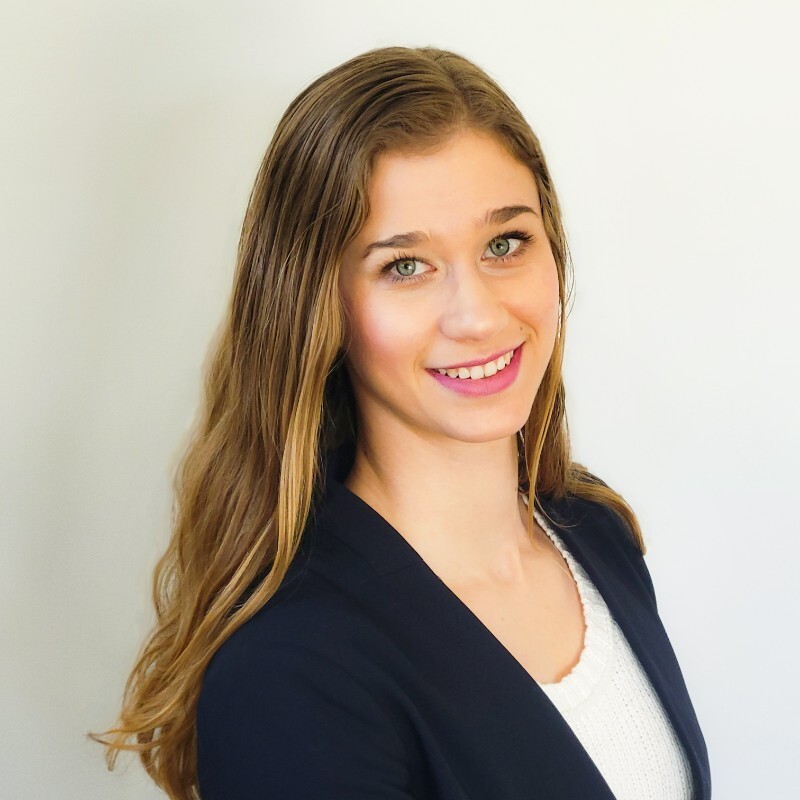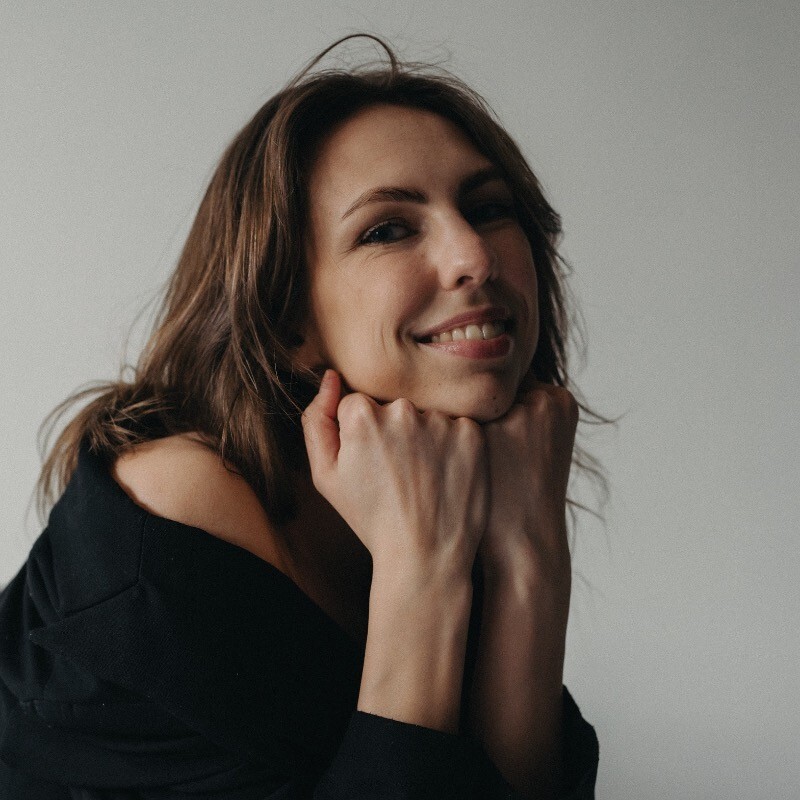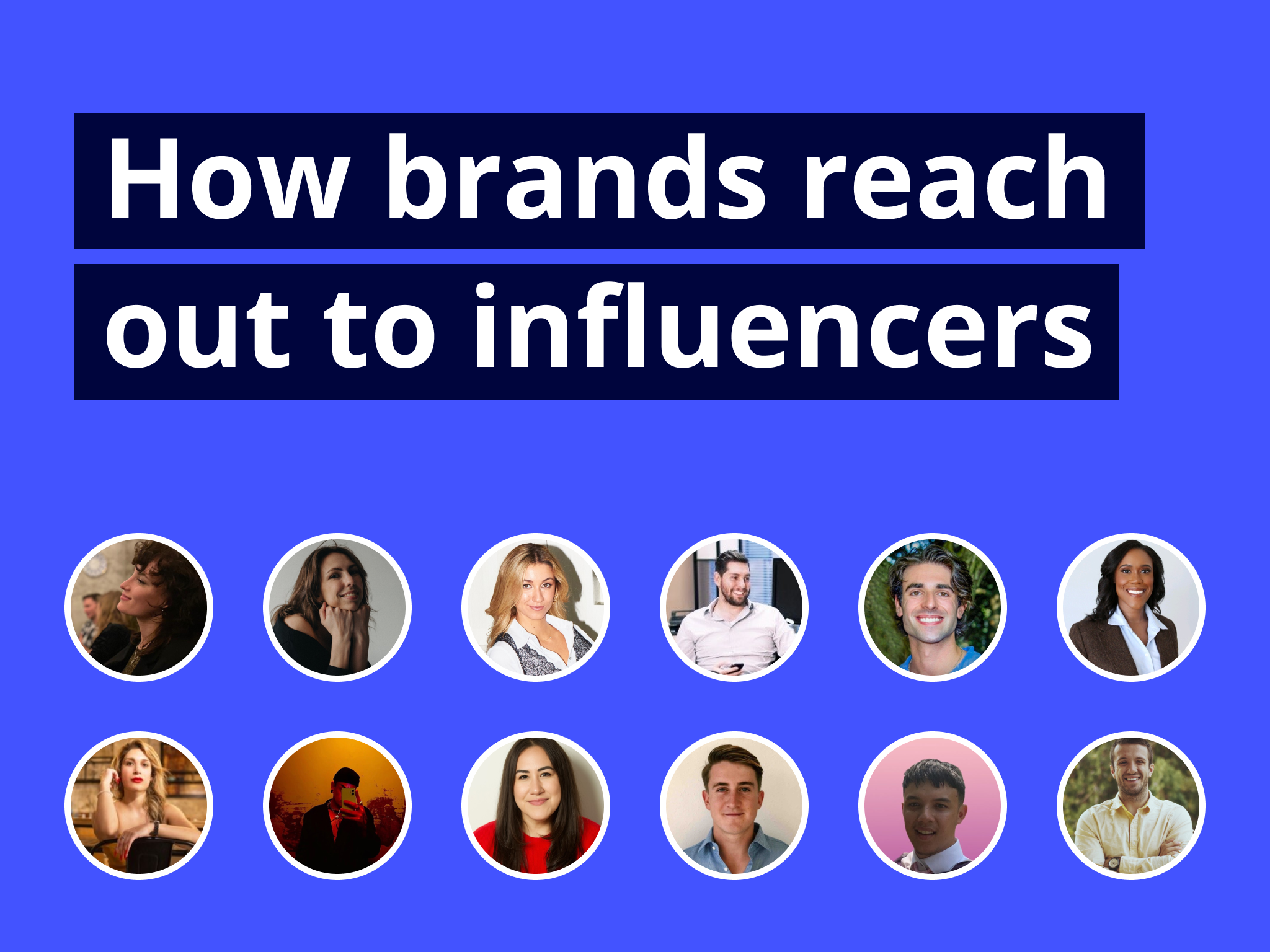I ran a survey to learn how pro influencer marketers actually find new influencer collabs.
Here, I’ve summarized the takeaways and advice on:
- Which methods are most effective for finding influencers
- Which social media platforms marketers are focusing on (and why)
- 6 tips from influencer marketers on scaling up your influencer recruitment
Which methods of finding influencers are the most effective?
There are two questions here:
- Which methods do marketers use to find influencers (in any capacity, yes or no), and
- Which are actually the most effective?
The most used were:
- Browsing directly within social platforms
- Using influencer search tools
- Researching competitor partnerships

And the methods rated most effective were:
- Browsing directly within social platforms
- Using influencer search tools
- Looking within your customer base
.png)
With the help of our contributors, I’ll add some commentary around some of these methods (not all – it’d get too long!), and the pros/cons.
Browsing within social platforms
I was surprised to learn that browsing directly within platforms like Instagram and TikTok came out on top.
There are obvious drawbacks (it’s slow, you can’t access audience/performance data easily). Yet the method is still highly rated.
Why?
After asking a few follow-ups, I learned a couple of solid arguments in favor of this method.
Nia Koleva, Influencer Marketing Manager at Gameloft, recommends putting yourself in the shoes of your target audience.
Try it out, and see who you come across organically.
Josie Hull, Creator Marketing Manager at Just Spices, found success by adapting her personal feeds around her target topics.
Doing that is likely useful for in-house marketers who intend to stay in the same niche for a long time. You can immerse in that world over time, and expect to come across talent organically.
Plus, it’s free. Anyone can get started using this tactic.
That said, the drawbacks still remain: it can take a long time, and you’d still ideally use a tool (or manually reach out) to verify creators’ audience and performance.
For those reasons, 75% of respondents also use software.
Using influencer search software
To start, let me clarify the types of search software, and how they work.
(Then, we’ll get into how influencer marketers use these tools.)
In my definition, there are two types of search software: opt-in databases, and open-network databases.
An opt-in database is what it sounds like. Creators opt to be in it, and often the company will have an approval process.
An example would be Upfluence.

The advantage is that all the creators are actively hunting for brand collabs. Response rates are higher. The disadvantage is the limited pool of talent.
Once you pick a platform (e.g. TikTok), a city or country, a niche (etc.) – you’ll filter down to a very small list, and just keep seeing the same faces in every search. The same faces all your competitors are finding too.
This effect is worse when you go outside of the US and into more unusual niches.
An open-network database like Modash is the opposite. It lists everybody. Every public profile. No matter which country, which city, which niche, literally every creator is in there – you just have to figure out the right filters to use.

It’s especially good for finding nano and micro creators who won’t have opted in to major opt-in databases and marketplaces.
Okay, moving on. Here’s how influencer marketers actually use search software.
To narrow down a search tool’s database, there are three main ways to filter:
- The audience demographics
- The influencer’s performance
- The niche
The importance of each can vary depending on your product and goals.
Here are some real examples:
Jordyn Marburger, Senior Influencer Marketing Manager at MELO, promotes vapes & diffusers in the U.S. As such, her starting point is to filter for an audience age of 18+, and predominantly U.S-based audience. Then, she layers in audience interests (like wellness, supplements).
Agita Matule, who manages influencer marketing at Wolt Latvia, starts with audience location filters and fake followers. The number of real people in her target city is the starting point, then she reviews content and other metrics from there.
Sahar Awan, Partnerships Manager at VURSE, uses a mixture: audience location / demographics, and performance metrics (like minimum engagement rate). Then to identify the niche, she searches based on words in influencer bios, or by hashtags used.
One last example. Valeriia Chemerys and Robert Polonski, who manage influencer collabs at Deeper, use four main filters as their starting point:
- 70%+ of the influencer’s audience in the target country
- Minimum engagement rate (usually no less than 3%)
- Niche identification using topics, hashtags, and bios
- A maximum fake follower percentage (e.g. no more than 25%)


From there, the team makes micro-adjustments, such as increasing/decreasing the engagement rate filter depending on the results.
Everyone’s approach varies slightly, but if I could boil everything down into some generic advice, I’d say:
- Start with the number of real people in your target market (fake followers, audience location/age/gender)
- If relevant, find a way to identify the niche (bio words are very specific, hashtags used bring some broader results)
- Then, if you still have a lot of profiles, start adding in performance filters like minimum engagement rate, average content views, follower growth rate, and so on.
Try not to go overboard on your first search. Add 1-2 filters at a time, and allow some trial and error.
Looking within your customer base
A lot of brands are having success recruiting influencers from their customer base.
Let's look at the pros and cons:
👍
- People already love your product. Content is more authentic
- They're likely excited to hear from a brand they love, and more likely to accept whatever terms you offer
👎
- Most of your customer base will probably be very small creators, and unlikely to be on-brand
- It's limited by the number of customers you already have
The influencer marketing team at Bolt are moving away from inbound methods like this one, for those reasons above. They choose to vet everyone for brand fit, rather than accepting everyone, and found that the majority weren't a fit. It isn't the highest leverage thing their small team could spend their time on. In comparison, with their outbound recruitment, they know every creator is a good fit before reaching out -- so there's no time wasted.
Anna-Maria Klappenbach (who leads influencer marketing at Aumio) has a slightly different approach. They have a separate affiliate program that anyone can join (as long as they've been a user for at least 2 weeks). It has fixed terms, and templated briefing, so the team doesn't spend any time on negotiations & back-and-forth with those smaller creators.
The trade off is, in their view, minimal brand risk (e.g. someone who isn't vetted says something slightly wrong about Aumio). And the benefit is that they gain some leverage from small creators they might otherwise miss out on.
If you have strict brand guidelines, that probably isn't the route for you -- and outbound will likely be more successful. But if you're not picky and you'd prefer to simply maximize the number of creators, consider taking a page from Aumio's book. (And listen to our podcast with Anna here).
Using an agency
In influencer marketing, an “agency” could mean either:
- A talent management agency (who represents creators), or
- An influencer marketing agency (a team you can outsource influencer marketing work to)
Here we'll focus on the former. You can expect a talent agency to be more expensive than working directly with a creator (the agency has to get paid!), which can make it prohibitive for some smaller brands.
Jordyn Marburger, Senior Influencer Marketing Coordinator at MELO, shares that agencies have simply been too expensive to be viable in her experience.
(Jordyn’s team prefers doing manual browsing, using software, and recruiting customers as affiliates.)
On the flip side, there are benefits. Especially for larger brands who want to collab with larger creators.
Namanh Hoang, Director of Branding at CyberPowerPC uses agencies as a key source of new influencer partnerships.
Talent agencies can also play a role in expanding your influencer efforts into new countries.
Piia Õunpuu, Global Influencer Marketing Manager at Bolt, sources around 15-20% of Bolt’s influencers through talent agencies. Most of these are in markets where there might be language barriers, or where local knowledge and connections can be generally helpful.
In conclusion? If you’re tight on budget, talent agencies probably aren’t the tactic for you. But if you’re looking to scale with the best talent in your niche, it’s worth investing time to build great relationships with talent agents.
Using a marketplace
When I hear “marketplace”, I think of things like Collabstr, where influencers are selling off-the-shelf packages for brands to buy. Like this:

This method was rated among the least effective for finding influencers.
Here are the main arguments against them:
1) Like opt-in databases, the talent pool is severely limited. All the creators there are actively hunting collabs and promoting other products. Easy for your competitors to find. No untapped micro creators.
2) You don’t fully “own” the relationship. Oftentimes it’s difficult to take that relationship outside of the marketplace.
3) Naturally, the marketplace will also take a cut of any fees paid.
That said, there are different types of marketplace models within influencer marketing.
Ben Williams rightly pointed out that there are specific circumstances in which marketplaces can be very effective.
He gives the example of LTK (formerly rewardStyle). Yes, it’s a marketplace with a limited pool of creators, but:
- You can get each creator’s actual historic sales performance as an affiliate
- If you need to scale really fast, it’s one of the only ways you can onboard 50+ mid-to-large creators in days

If you’re working at a larger brand (one that is desirable for influencers to work with), and you’re in a fairly broad category like fashion or beauty, this could work well.
If you’re looking for more specific content types and more niche audiences, it’s probably not for you. Plus, LTK has a relatively high onboarding fee for brands to get started which could be prohibitive for smaller brands.
Which social platforms do influencer marketers focus on?
Do influencer marketers focus on hunting platform-specific influencers? If so, which?
The big three are no surprise:
- 75% of marketers are looking for influencers on Instagram
- 67% of marketers are looking for influencers on TikTok
- 60% of marketers are looking for influencers on YouTube
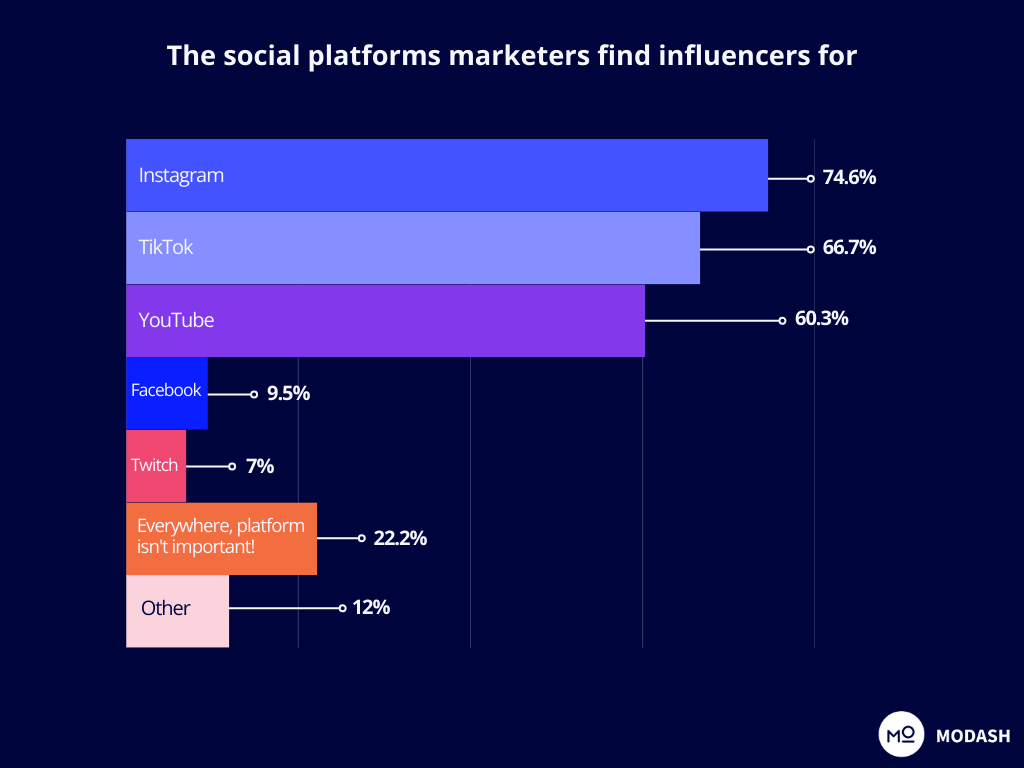
But why? How can you decide where to focus if you’re kicking off influencer marketing at a brand for the first time?
Here’s a few tips, starting with wise words from Emily Claire Hughes, a writer and influencer marketing consultant.
Step 1: figure out where your audience hangs out online. Sounds obvious, but easy to forget.
Salma Elframawy, an Influencer & Affiliate Marketer at Vivian Agency, adds that the nature of your product will dictate, to an extent, where your efforts are best placed.
Instead, evergreen (searchable) content on YouTube (and even TikTok) might be better suited for the insurance example. That way, the content can be discovered when the person actually starts their research.
Salma adds that the complexity and size of the purchasing decision matters too.
If it’s a big decision (or if the product is difficult to understand), long-form video content on YouTube allows for more detailed explanations. James Wilkinson, who runs YouTuber collabs at BalanceOne cited that exact benefit in relation to their supplement products.
As a final point, I’d add that you should be realistic about your resources. Don’t try to be everywhere if you’re a team of 1.
Yes, run tests. Try new things. But don’t go crazy. You won’t be able to draw any reliable conclusions by doing 1 collab on 6 different platforms anyway. There’s an advantage to building out your network within one platform/community, and deeply understanding the algorithm and different content formats, before expanding.
6 More tips from marketers on finding new influencers
1. Look outside your core niche
Broadening your search and testing new niches was a common piece of advice given by pro influencer marketers.
Marketers sometimes get stuck looking for influencers within very narrow and unrealistic criteria. It’s usually possible to step back, and brainstorm new types of creators that still reach your target audience.
Jenny Song Schmidt, an influencer marketing consultant, shared a relevant example:
Here’s another real-world example from Metabolic Meals, who deliver nutritional meals to people’s doorsteps. Fitness influencers are the obvious go-to niche, but they think beyond that too. Busy moms are another target group – who might not have the time to whip up something healthy and delicious for their kids. Metabolic Meals partner with both kinds of influencer— from athletes like Allison to moms like Sharon.

Palina Viarbitskaya, Influencer Relations Manager at The Bold Stroke has some advice on how to approach testing new niches.
Dmitri Cherner, Head of Influencers at OneSkin advises that you start by heavily testing new niches, and reduce the percentage of tests over time.
The bottom line? As long as the target locations and demographics of creators are accurate, you can experiment with the exact niche and content types.
2. Consider running multiple influencer programs at once
If you only run one type of influencer collaboration, there’s a good chance you’re leaving value on the table.
Piper Philips, Director of Marketing at Tru manages two main groups of influencers. An “always on” gifting program which is constantly recruiting, and a higher level program with bigger (paid) creators with varying needs.
To give one more example, Deeper Sonars also runs three ambassador programs. They recruit fishing creators from hobbyists, to professionals, to influencers with larger audiences. Each group is managed and compensated differently (read more here).

This route is particularly attractive if you have inbound interest, but those creators often aren’t a good fit. Instead of rejecting them, consider opening a separate program, e.g. free products only, or affiliate commission only.
That way you can still drive some value from inbound talent, but minimize the amount of time your team spends negotiating and managing small creators (who might never actually drive a sale).
3. Run trial periods before engaging in long-term partnerships
Many marketers are hunting for long-term collabs. Short-term collabs (for many brands, but not all) simply exist as the pipeline for finding long-term partners.
But remember that influencers are real people. If you commit to a 6-12 month contract, you can’t just turn it off like an ad campaign. You need to be confident before making the long-term commitment.
Which means trial periods.
Omer Mohamed, Head of Social Media & Influencer Marketing at Bang & Olufsen, recommends just being transparent with creators when pitching a trial period.
It’s easy to understand, and benefits the creator too.
During his time at FARFETCH, Ben Williams would use the potential of a long-term partnership during the initial trial phase as an incentive for creators.
4. Scaling up doesn’t always have to mean adding more influencers
Nycole Hampton points out that having “enough influencers” isn’t always the right problem to solve.
If you’ve found content that performed really well, there’s a good chance it’ll work as a paid ad creative too. Develop the impact further by using whitelisting (on Meta) or Spark Ads (on TikTok) to run it as an ad from the influencer’s account and reach new people.
It can make for a great way to scale influencer impact, without recruiting more influencers.
5. If negotiations don’t work out this time, record it and revisit in future
Teri Simone, Head of Marketing & Design at Nieu Cabinet Doors regularly comes across influencers who aren’t a fit right now, for various reasons. She records those instances, ready to revisit if things change.
If negotiations break down at the final hurdle, never say never.
End the current conversation on a positive note, maintain a positive relationship, and consider revisiting in the future.
You’ll quickly build up a pipeline of potential future influencers who either loved your brand enough to reach out to you, or you deemed a good enough fit to reach out to them.
6. Wherever you're sourcing influencers from, vet their profiles
If you want a collab to drive sales, the number one factor in influencer selection is the audience. Is this influencer actually reaching real people, in your target locations, in your target demographic?
If you don’t have that data when a collab opportunity first arises, find a way to get it before pulling the trigger.
Influencer analysis tools are the easiest way, but if you don’t have one, ask for screenshots from Instagram/TikTok insights. Ask for historic campaign performance. Run the profile through a free fake follower checker. Whatever you can do to verify the real people, in your target locations, in your target demographic.
Zeina Elmasry, Influencer Marketing Coordinator at Huda Beauty receives many requests organically from content creators for product gifting. She reviews media kits based on engagement rates, content, and follower count – and uses an influencer marketing platform to evaluate who is worth building a relationship with.
When Bolt is sent a potential collab from a talent manager, even one they have a trusted relationship with, they still check the audience & content in Modash. It lets you check fake followers, get audience details (locations/ages/genders), a benchmarked engagement rate, the creator’s past sponsored posts, and more. It looks like this:

The more you spend on a collab, the more important this step becomes.
A note on participants in this survey
In case you’re wondering: “Okay, but are the survey respondents actually like me? Is this relevant?”
We have a mixture of in-house marketers (mostly ecommerce), and influencer marketing agencies.
And the type of collabs they’re working on? Primarily:
- Paying influencers up front for deliverables
- Regular free products and/or seeding campaigns
- And slightly less commonly, recruiting commission-based affiliates
Here’s the breakdown:
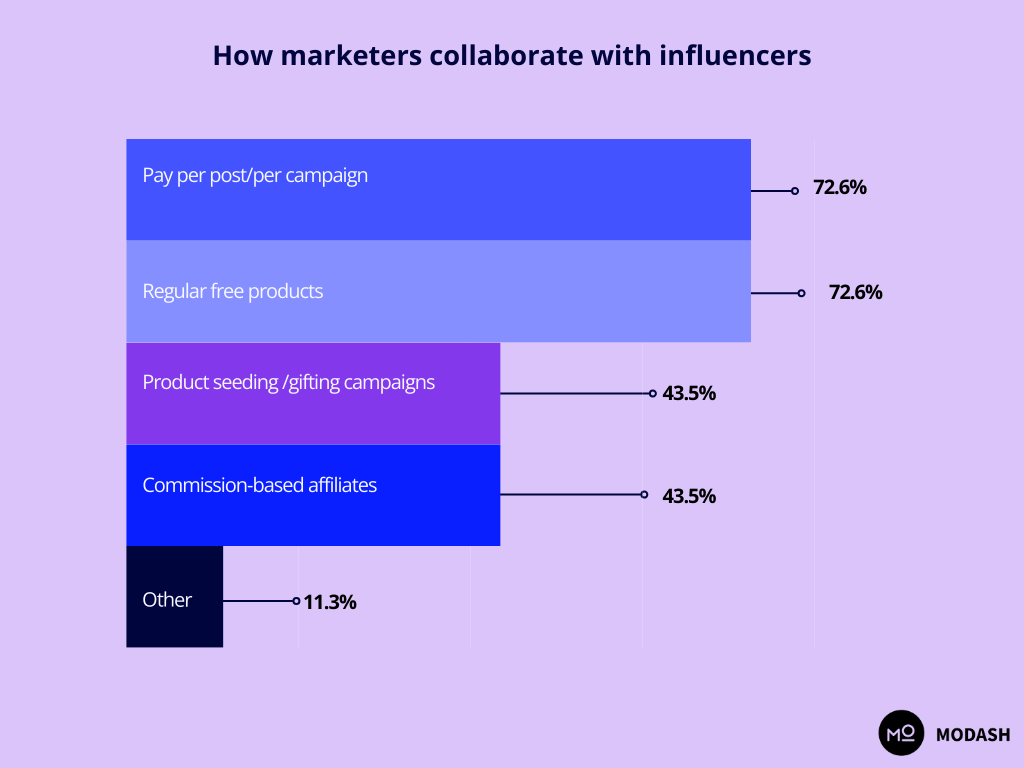
What’s next?
Even though there’s a couple of dominant methods, right now most brands use a variety of methods to source influencer talent.
Here are some closing words from Nycole Hampton:
“Finding great partners isn't a single tactic process. You have to do the legwork to find the right people.”
If you want a more detailed example on the exact mix of tactics that a brand is using to find influencers, here's two different breakdowns:
And if you’re ready to try an influencer search tool that:
- *Actually* has enough influencers in your niche (literally, everybody with 1k+ followers)
- Has accessible pricing plans and self-serve options
- Gives you the audience data you need *before* you spend time on outreach
Then, give Modash a spin for free.













